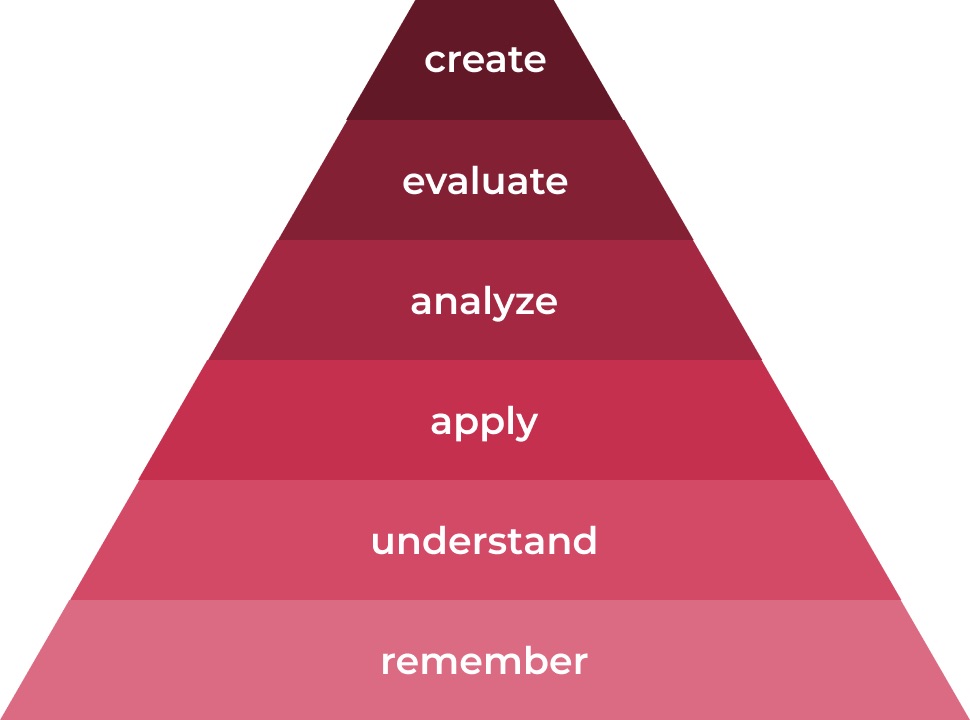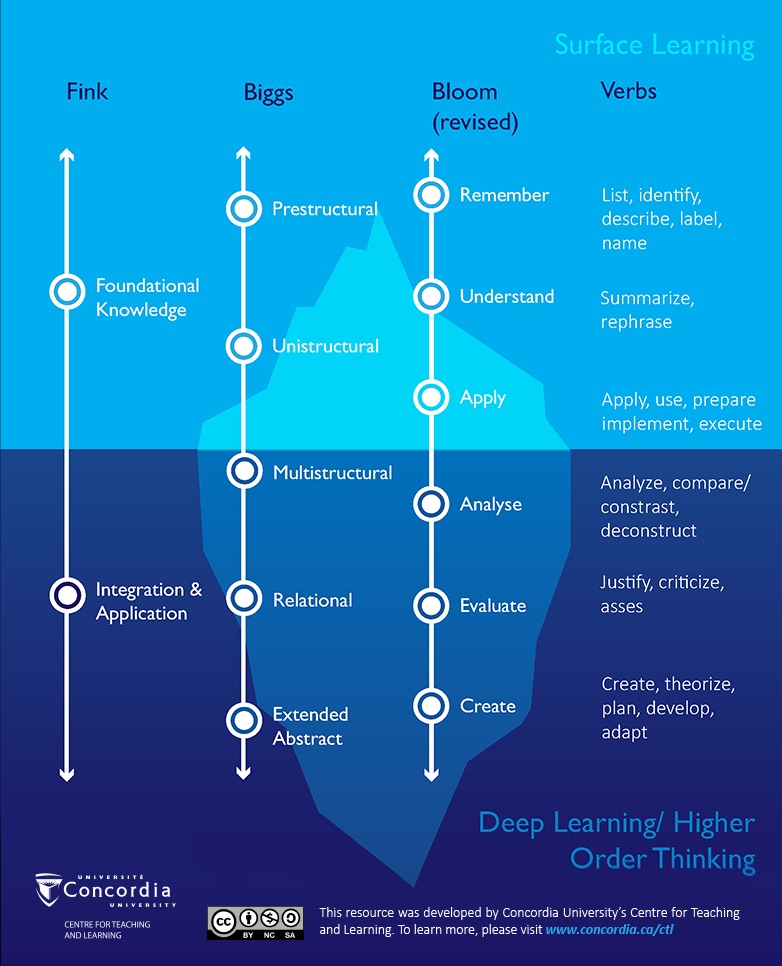Levels of learning
In brief
Learning outcomes identify the level or depth of learning you expect from your students, and what they will be able to do with their learning:
- A learning taxonomy can help you identify the level of cognitive learning you are targeting, from foundational knowledge, like memorizing, to higher-order thinking, like analyzing.
About Bloom’s taxonomy
Benjamin Bloom (1956) and colleagues developed the most widely used learning taxonomy of educational objectives. Initially published in 1956, it was revised by Anderson et al. (2001).
The taxonomy classifies learning into six main categories: essential, factual learning at the base or foundation and higher-order skills and abilities at the top. The verbs at each level reflect the learner’s cognitive processes when working with knowledge. These skills and abilities build from simple to complex.
Bloom’s taxonomy of the cognitive domain is commonly represented in a pyramid, with associated observable and measurable verbs for each level of knowledge.

Key takeaways
You can clarify your course learning expectations by selecting the verb that best describes the depth of learning students need to reach.
Applying Bloom’s taxonomy to your learning outcomes
The table below identifies verbs that articulate measurable ways to observe your learning outcomes. Note that this table is not a comprehensive list of verbs.
| Level of learning | What is expected | Verbs that describe observable & measurable learning |
| Remember | Students can recall basic facts, concepts or theories | describe, define, label, list, arrange, name, memorize, reproduce, quote, state, select, identify |
| Understand | Students can explain ideas or concepts. | discuss, explain, identify, describe, summarize, compare, locate, reiterate ideas and theories, illustrate |
| Apply | Students can use knowledge, theories or concepts in new situations. | apply, demonstrate, use, construct, solve, respond, complete, practice, conduct, perform, employ, dramatize |
| Analyze | Students can make connections between ideas, theories or concepts. | classify, review, exemplify, distinguish, categorize, test, experiment, quantify, critique, debate, differentiate, measure, relate, extrapolate, theorize |
| Evaluate | Students can judge or assess ideas, theories or concepts according to criteria. | assess, critique, choose, appraise, compare, conclude, review, defend, rate, measure, justify, judge |
| Create | Students can integrate knowledge, theories or concepts to create a new understanding. | develop, plan, design, formulate, establish, integrate, modify, compose, construct, devise, build, propose |
It is also important to note that the assessment methods you use in your course should match the level of learning articulated in your learning outcomes as verbs can be representative of learning at more than one level, depending on the context.
Compare:
Describe the responsibilities of students during their internship.
With:
Describe the rationale you applied to your decision-making process when faced with challenges during your internship.
Levels of learning in different learning domains
Biggs & Collis’s SOLO Taxonomy (2014), Dee Fink’s Taxonomy of Significant Learning (2013) and David Krathwohl et al.’s Affective Domain Taxonomy (1954) are among some of the other learning taxonomies that are widely ascribed to across higher education. Regardless of which taxonomy you subscribe to, what’s most important is to identify the level of learning you want students to reach and this should be clearly articulated in your learning outcome.

Download the full descriptive alt text for the above infographic
Resources
- For more information, see this Guide to Taxonomies of Learning Outcomes.
- For learning outcomes that focus on attitudes, motivation, values, etc. Krathwohl, Bloom, & Masia’s five categories in the Affective Domain can be used to write learning outcomes.
- For discipline areas that target procedural learning, techniques in task performance, precision, etc. Simpson’s seven categories in the Psychomotor Domain could also help guide the learning outcomes.
References
Anderson, L. W., Krathwohl, D. R., Airasian, P. W., Cruikshank, K. A., Mayer, R. E., Pintrich, P. R., Raths, J., & Wittrock, M. C. (2001). A Taxonomy for Learning, Teaching, and Assessing: A Revision of Bloom’s Taxonomy of Educational Objectives. New York: Longman.
Biggs, J. B., & Collis, K. F. (2014). Evaluating the quality of learning: The SOLO taxonomy (Structure of the Observed Learning Outcome). Academic Press.
Bloom, B. S. (1956). Taxonomy of educational objectives: The classification of educational goals. Cognitive domain.
Fink, L. D. (2013). Creating significant learning experiences: an integrated approach to designing college courses (Rev. and updated, Ser. Jossey-bass higher and adult education series). Jossey-Bass.
Krathwohl, D. R. (2002). A revision of Bloom’s taxonomy: An overview. Theory into practice, 41(4), 212-218. https://doi.org/10.1207/s15430421tip4104_2
Krathwohl, D. R., Bloom, B., & Masia, B. (1956). Taxonomy of educational objectives. Handbook II: Affective domain. New York: David McKay.

